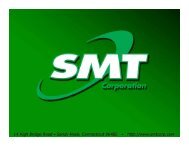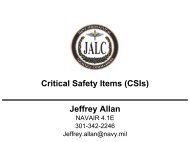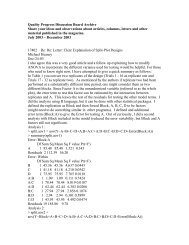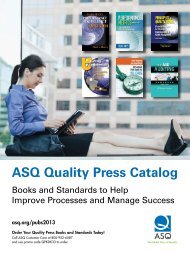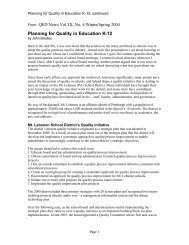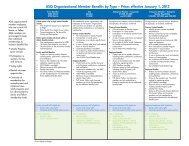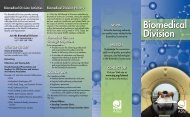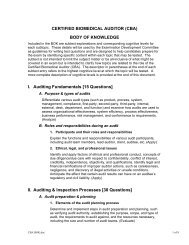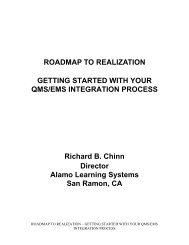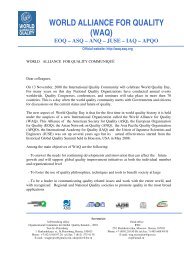Malcolm Baldrige National Quality Award - American Society for ...
Malcolm Baldrige National Quality Award - American Society for ...
Malcolm Baldrige National Quality Award - American Society for ...
You also want an ePaper? Increase the reach of your titles
YUMPU automatically turns print PDFs into web optimized ePapers that Google loves.
It creates multiple levels of leadership review of the AP be<strong>for</strong>e<br />
it is marked with an “Approved” status. At each level, the<br />
approver has the ability to provide feedback and return the AP<br />
back to the owner. This multi-level review ensures key<br />
outcomes are achievable and can be sustained. Once an AP is<br />
approved, the AP owner can proceed with recording frequent<br />
status updates as well as creating the required quarter reports.<br />
Work plan status updates are reported quarterly via the APQR<br />
and include details on process measures, progress made,<br />
lessons learned, and next steps. At the end of each quarter, the<br />
APQR are reviewed and approved through the approval chain.<br />
This process allows leaders to identify actions and resources<br />
needed to sustain or spread the outcomes of work plans. APs<br />
are available to all employees via the intranet. All employees<br />
can access and view AP, associated status updates, quarterly<br />
reports and all associated work plans within the organization.<br />
SCF also actively shares plans with key external partners [Fig.<br />
P.1-7]. The VPLT communicates SCF’s plans to ANTHC<br />
during various meetings of the JOB, its subcommittees and<br />
Executive Management Team as well as other key partners<br />
[P.1b(3)], enabling the primary care (i.e., SCF) and specialty<br />
hospital care (ANTHC) to work collaboratively across the<br />
continuum.<br />
Recent improvements to the annual planning piece of the SPC<br />
include involving a “coordinator” early on in AP development<br />
to review and provide feedback. This process includes<br />
reviewing APs with AP owners and a division designee to<br />
improve awareness of how work plans are linked to corporate<br />
initiatives. This provides another opportunity to capture blind<br />
spots. The FCS [Fig. 1.1-2] now also includes a subcommittee<br />
of the PI Committee responsible <strong>for</strong> facilitating the SPC.<br />
2.2a(3) Resource allocation: SCF ensures that financial<br />
resources are available by planning, <strong>for</strong>ecasting, and seeking<br />
partnerships and funding. Revenues <strong>for</strong> the next fiscal year<br />
(beginning October 1) are <strong>for</strong>ecasted several months during<br />
the January-March period of the SPC. Forecasts are largely<br />
based on actual results from the most recent full fiscal year,<br />
and year-to-date results from the current fiscal year. Any other<br />
known or “<strong>for</strong>ecastable” factors are considered to determine a<br />
final estimate to be used <strong>for</strong> budget preparation. Such factors<br />
may include inflation or volume assumptions, overall or by<br />
service lines; expected Congressional appropriation increases<br />
or decreases (a percent of SCF funding comes as an IHS<br />
appropriation); new or terminating grant funding; significant<br />
changes in Medicaid payment methodology (a substantial<br />
portion of third-party payments are from Medicaid); and, new<br />
programs planned. Financial projections <strong>for</strong> new business<br />
investments are based on market and payor in<strong>for</strong>mation and<br />
include start-up, phase-in, and fully implemented or “mature”<br />
budgeted amounts. If the start-up, phase-in, or fully<br />
implemented new business is not expected to generate enough<br />
revenue to cover the expenses, an allocation from corporate<br />
reserves is identified and designated.<br />
Assessment of financial risks is an ongoing process based<br />
largely on recent past and current financial results from<br />
operations, as well as general knowledge of SCF’s<br />
marketplace and regulatory environment. SCF <strong>for</strong>mulates<br />
long-term financial plans with the knowledge that it is not<br />
possible, or even desirable, to maintain operating margins at<br />
10<br />
the levels experienced 10 years ago. Long-term financial<br />
planning at SCF includes evaluating levels of service which<br />
can be supported based on funding projections.<br />
The VPLT also monitors the impact of the influx of AN/AI to<br />
the Anchorage area based on SCF’s financial position.<br />
Because it is understood that this immigration of C-O is<br />
causing expenditures to grow faster than offsetting revenue,<br />
managers are held accountable <strong>for</strong> managing to the budgeted<br />
bottom line <strong>for</strong> each program. SCF’s Finance Division tracks<br />
and monitors revenue and expenses and identifies deviations<br />
from anticipated levels. The Revenue Committee monitors and<br />
communicates third party net revenue results, addresses<br />
revenue-related opportunities <strong>for</strong> improvement and<br />
recommends opportunities to enhance net revenue. In order to<br />
increase funded services to its existing and expanding C-O<br />
base, SCF is implementing additional Medicare and Medicaid<br />
funded activities, improving cost reporting to enhance costbased<br />
reimbursement, working with state service delivery<br />
departments and the Medicaid program, making revenue<br />
in<strong>for</strong>mation available to managers in the Data Mall, reviewing<br />
its revenue cycle and hiring employees to implement revenue<br />
cycle improvement. The Revenue Committee sponsored a<br />
work group to research Medicaid enrollment trends and<br />
identify opportunities to enhance this critical revenue source.<br />
SCF manages its costs by making expenditure in<strong>for</strong>mation<br />
available to managers, involving managers in budget<br />
development, developing tools to track costs over time,<br />
changing its model of care to emphasize wellness and active<br />
management of chronic disease, addressing the family as a<br />
unit, eliminating duplication and multiple visits to the greatest<br />
extent possible, allowing employees to “work to the limit of<br />
their license,” and targeting complex users of services to<br />
identify what type of services these C-O really need.<br />
SCF takes an active role in its relationship with funding partners,<br />
including the IHS; the State of Alaska, its largest third-party<br />
payor via the Medicaid program; and the Alaska Mental Health<br />
Trust Authority, in policy and operational matters. The<br />
relationships serve to identify current and future needs, and<br />
allow <strong>for</strong> policy development, problem solving, identifying<br />
elements of risk and working together to resolve them.<br />
To support appropriate work<strong>for</strong>ce planning levels, SCF uses a<br />
comprehensive staffing <strong>for</strong>mula that enable it to project, <strong>for</strong><br />
every 1,200 C-O empanelled, the FTE and cost to sustain its<br />
action plan changes. Projected staffing needs drive HR’s<br />
Corporate Recruitment Plan, which includes strategies <strong>for</strong><br />
providers, clinical support staff, administrative support and<br />
other employees. These <strong>for</strong>mulas serve to ensure that realistic<br />
budgets are set to accomplish long-term staffing needs along<br />
with short-term solutions, such as temporary and contract<br />
workers [5.2a(1)].<br />
2.2a(4) Work<strong>for</strong>ce plans: Growth in the AN/AI population in<br />
Anchorage and increased C-O demands <strong>for</strong> service have<br />
significant implications <strong>for</strong> staffing. SCF supports<br />
accomplishment of its CO and action plans with HR and DC<br />
APs. The HR and DC departments use a combination of<br />
<strong>for</strong>mal and in<strong>for</strong>mal feedback to improve or add programs<br />
[5.1b(2)]. A major focus of these APs is building SCF’s<br />
work<strong>for</strong>ce capability by attracting employees, increasing the



